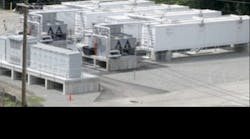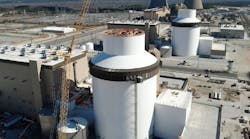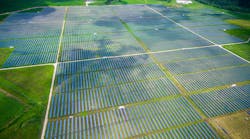On Oct. 17, 2013, the California Public Utilities Commission (CPUC) established an energy storage target of 1,325 megawatts for Pacific Gas and Electric Company, Southern California Edison, and San Diego Gas & Electric by 2020, with installations required no later than the end of 2024.
Wow! This has been a while in the making but it still caught a lot of us in the industry by surprise. Up to now, California utilities have been prevented from building significant energy storage. However, storage is badly needed to mitigate the impacts of the exponentially growing amount of intermittent (solar, wind) generation in the state. See Solar Will Shine Brighter With Smarter Inverters.
The new ruling not only allows the states utilities to build storage in support of optimizing the grid, but even gives them a target.
This seems like a good thing to me (many of the California utility commission meanderings don't) and I wanted to discuss the implications a bit with someone intimately knowledgeable about the (arcane to many of us) Commission gyrations. That someone would be Dr. Merwin Brown co-director of Electric Grid at the California Institute for Energy and Environment and a member of our Grid Optimization expert panel. Merwin has a PhD in nuclear engineering and was research director at Pacific Gas And Electric, among many, many other posts and accomplishments. Along the way he's helped develop strategies for utilities and state agencies to navigate their way to new utility practices that sensibly incorporate renewable generation.
(The only blemish on his record might be that I worked under him for a while at PG&E!)
Mauldin: Dr. Brown, up to now, storage, any kind of storage has been considered generation in California, hasn't it?
Brown: Mostly, but there have been some instances of California utilities being able to install storage as a grid asset primarily to stabilize the grid rather than add to system generation support. I think FERC also muddies the waters here a bit.
Mauldin: But, in general, since California has deregulated its utility industry, utilities can't own generation, right?
Brown: Again, there are exceptions, and I would say it a different way. The ban on owning generation was more of a legacy from the deregulation experiment, but now the situation is more gray than black or white. But I know where you're going. California utilities have been, in general, prevented from owning generation. So if storage is considered generation then the utilities won't be building the badly needed storage to support the grid.
Mauldin: Seems to me that a major problem has been that no one else would build new storage either because the pricing of capacity and demand, based on the generator model, isn't sufficient for storage and the rate making would take forever to settle creating a huge investment risk. Is that a fair statement?
Brown: I see this a little differently. It’s more of an issue with getting multiple benefits from one asset because, there has been resistance to letting utilities install storage as a grid asset if it appears it could be used as generation for arbitrage. And the power markets, where energy storage can unabashedly play the generation role have not been robust enough to easily capture the value of the multiple benefits of energy storage.
Mauldin: But if you regulate storage as an asset to support the grid, and provide it with ROI like other assets then building storage, big storage, makes sense. The utility has an opportunity to add expensive assets even if load growth is low. In fact, the more solar, the more need for storage so it takes the sting out of solar over-build. And the more storage, the bigger return to utility investors
Brown: Don't forget wind, which is an even bigger oversupply issue because of the seasonal and daily timings of its availability. However, I think, given the kind of storage being talked about in this decision, storage’s role is not so much a long term time shift of renewable resource availability, but more of a role in addressing ramp rates, instabilities, inertia, volt/VAR support and short term grid capacity constraints.
Mauldin: But pumped storage is excluded. I'm not sure why.
Brown: Not sure why either but suspect that they wanted to make sure that few existing or pending pumped storage installations wouldn’t steal the whole show, leaving little left for the “emerging” stuff and utilities can only own 50% of new storage-leaving room for others. And I suspect the 50% was to encourage the energy storage startups who want the potential to earn returns through multiple revenue streams via contract terms. But beware of that answer because I’m guessing.
Mauldin: Seems like everyone benefits, even the rate payer, providing that the increase in rates due to storage is offset by decrease in generation costs due to unfettered growth of renewables. The Commission made a nice move all around, wouldn't you say?
Brown: Yes, but with the above caveats. It will take a while for the details and implementation issues to sort themselves out. This is not going to bring an overnight cure to California's problems with the variable renewable generators and looming grid instability. Also, in principle, I’m bothered by targets for storage, as contrasted to targets for renewables. It is relatively easy to set targets for the latter to reach certain environmental goals, but knowing how much storage is too little or too much is a much more complicated systems problem and is quite situation dependent. But some experts have told me that the target chosen – on what basis I haven’t been able to find out - is probably conservative, and it's a big step in the right direction. Certainly the storage technology industry will be encouraged to invest in innovation and capital for their expansion will be much more available.
MauldinThink other states will follow suit?
Brown: Eventually. As you once said in an article, hula hoops, pet rocks, politics – history shows that most California trends drift east.
Mauldin: Thanks for your time, Merwin!
Brown:You bet!


